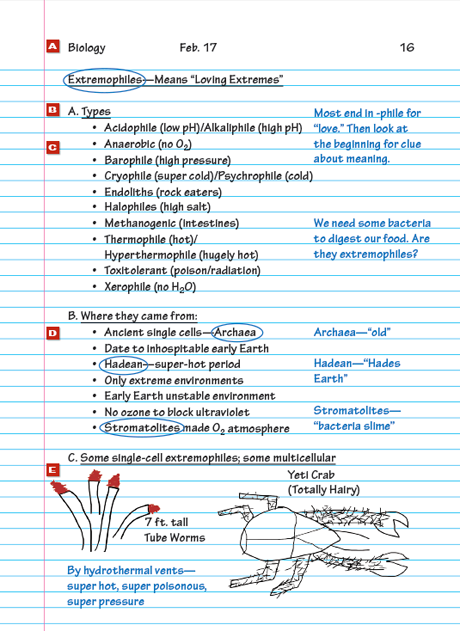128
Taking Classroom Notes
Almost every day in class, teachers present new information. One helpful way to engage this material and begin to understand it is to take notes. Note taking requires you to translate ideas into your own words and make your own connections. It also provides a record of information you must learn. Here are some note-taking tips.
- Use an effective format. For example, you can use a two-column format, writing your main notes in a wide column on the left and questions and comments in a narrow column on the right. (See page 129.)
- Consider digital options. You can key notes into a word processing program, or you can keep digital notes using an application such as Evernote or Catch. These programs also make it easy to save links, images, videos, and other media files.
- Label your notes with the class name, topic, and date. Also number the pages to keep them in order.
- Record information that your teacher writes on the board.
- Listen for signal words in the lecture, such as “Notice how . . . ,” “Please be aware that . . . ,” or “There are three kinds of . . . .”
- Underline or star key information so that you can return to it easily.
- Use numbered lists for sequentially ordered information. Use bullets or short dashes for lists of nonsequential details.
- Draw pictures and diagrams that illustrate the main point.
- Write down new vocabulary words, along with definitions. Circle words as a reminder to check the spellings and definitions.
- Use a personal shorthand. Focus on recording key words and phrases rather than writing complete sentences.
- Record references to further information, such as page numbers in your textbook or useful Web sites.
- Read your notes later to review the information and begin learning it. By reviewing your notes in a different place, you send a signal to your brain that you will need to use the material in more than one context.
Your Turn Which of the note-taking tips above do you already practice? Which do you need to adopt or improve upon? Explain your answers in a brief paragraph.
129
Sample Note Page
For handwritten notes, use a wide column on the left for your main notes and a narrow one on the right for questions, comments, and vocabulary words. If you keep notes digitally, type text and use links, images, comments, and other features.
A Label each note page, telling the class and date.
B Underline major topics and subtopics.
C Use numbered, lettered, and bulleted lists to organize details.
D Circle new vocabulary words and come back later to write definitions.
E Draw pictures to help you recall key details.


